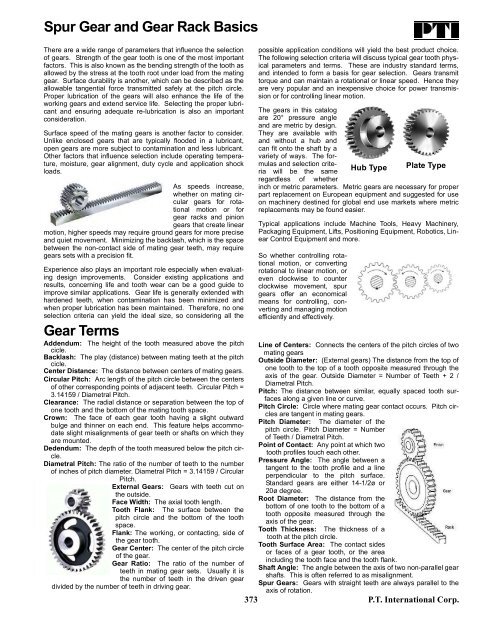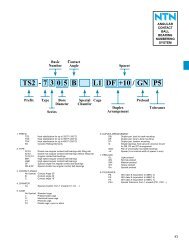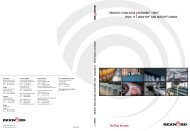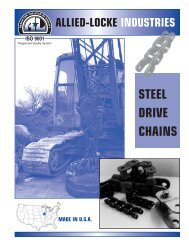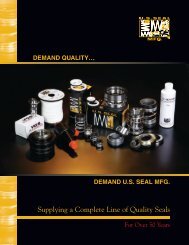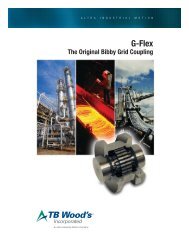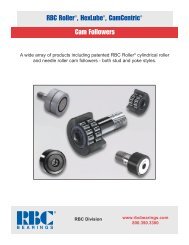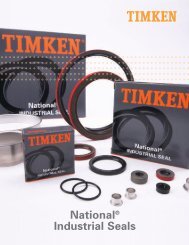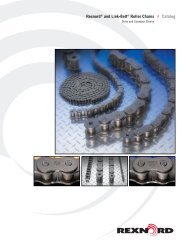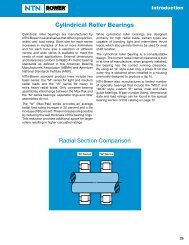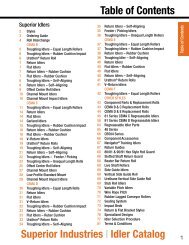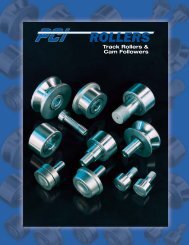PTI Bearing Catalog - Norfolkbearings.com
PTI Bearing Catalog - Norfolkbearings.com
PTI Bearing Catalog - Norfolkbearings.com
You also want an ePaper? Increase the reach of your titles
YUMPU automatically turns print PDFs into web optimized ePapers that Google loves.
Spur Gear and Gear Rack Basics<br />
There are a wide range of parameters that influence the selection<br />
of gears. Strength of the gear tooth is one of the most important<br />
factors. This is also known as the bending strength of the tooth as<br />
allowed by the stress at the tooth root under load from the mating<br />
gear. Surface durability is another, which can be described as the<br />
allowable tangential force transmitted safely at the pitch circle.<br />
Proper lubrication of the gears will also enhance the life of the<br />
working gears and extend service life. Selecting the proper lubricant<br />
and ensuring adequate re-lubrication is also an important<br />
consideration.<br />
Surface speed of the mating gears is another factor to consider.<br />
Unlike enclosed gears that are typically flooded in a lubricant,<br />
open gears are more subject to contamination and less lubricant.<br />
Other factors that influence selection include operating temperature,<br />
moisture, gear alignment, duty cycle and application shock<br />
loads.<br />
As speeds increase,<br />
whether on mating circular<br />
gears for rotational<br />
motion or for<br />
gear racks and pinion<br />
gears that create linear<br />
motion, higher speeds may require ground gears for more precise<br />
and quiet movement. Minimizing the backlash, which is the space<br />
between the non-contact side of mating gear teeth, may require<br />
gears sets with a precision fit.<br />
Experience also plays an important role especially when evaluating<br />
design improvements. Consider existing applications and<br />
results, concerning life and tooth wear can be a good guide to<br />
improve similar applications. Gear life is generally extended with<br />
hardened teeth, when contamination has been minimized and<br />
when proper lubrication has been maintained. Therefore, no one<br />
selection criteria can yield the ideal size, so considering all the<br />
Gear Terms<br />
Addendum: The height of the tooth measured above the pitch<br />
cicle.<br />
Backlash: The play (distance) between mating teeth at the pitch<br />
cicle.<br />
Center Distance: The distance between centers of mating gears.<br />
Circular Pitch: Arc length of the pitch circle between the centers<br />
of other corresponding points of adjacent teeth. Circular Pitch =<br />
3.14159 / Diametral Pitch.<br />
Clearance: The radial distance or separation between the top of<br />
one tooth and the bottom of the mating tooth space.<br />
Crown: The face of each gear tooth having a slight outward<br />
bulge and thinner on each end. This feature helps ac<strong>com</strong>modate<br />
slight misalignments of gear teeth or shafts on which they<br />
are mounted.<br />
Dedendum: The depth of the tooth measured below the pitch circle.<br />
Diametral Pitch: The ratio of the number of teeth to the number<br />
of inches of pitch diameter. Diametral Pitch = 3.14159 / Circular<br />
Pitch.<br />
External Gears: Gears with teeth cut on<br />
the outside.<br />
Face Width: The axial tooth length.<br />
Tooth Flank: The surface between the<br />
pitch circle and the bottom of the tooth<br />
space.<br />
Flank: The working, or contacting, side of<br />
the gear tooth.<br />
Gear Center: The center of the pitch circle<br />
of the gear.<br />
Gear Ratio: The ratio of the number of<br />
teeth in mating gear sets. Usually it is<br />
the number of teeth in the driven gear<br />
divided by the number of teeth in driving gear.<br />
possible application conditions will yield the best product choice.<br />
The following selection criteria will discuss typical gear tooth physical<br />
parameters and terms. These are industry standard terms,<br />
and intended to form a basis for gear selection. Gears transmit<br />
torque and can maintain a rotational or linear speed. Hence they<br />
are very popular and an inexpensive choice for power transmission<br />
or for controlling linear motion.<br />
The gears in this catalog<br />
are 20° pressure angle<br />
and are metric by design.<br />
They are available with<br />
and without a hub and<br />
can fit onto the shaft by a<br />
variety of ways. The formulas<br />
and selection criteria<br />
will be the same<br />
Hub Type Plate Type<br />
regardless of whether<br />
inch or metric parameters. Metric gears are necessary for proper<br />
part replacement on European equipment and suggested for use<br />
on machinery destined for global end use markets where metric<br />
replacements may be found easier.<br />
Typical applications include Machine Tools, Heavy Machinery,<br />
Packaging Equipment, Lifts, Positioning Equipment, Robotics, Linear<br />
Control Equipment and more.<br />
So whether controlling rotational<br />
motion, or converting<br />
rotational to linear motion, or<br />
even clockwise to counter<br />
clockwise movement, spur<br />
gears offer an economical<br />
means for controlling, converting<br />
and managing motion<br />
efficiently and effectively.<br />
Line of Centers: Connects the centers of the pitch circles of two<br />
mating gears<br />
Outside Diameter: (External gears) The distance from the top of<br />
one tooth to the top of a tooth opposite measured through the<br />
axis of the gear. Outside Diameter = Number of Teeth + 2 /<br />
Diametral Pitch.<br />
Pitch: The distance between similar, equally spaced tooth surfaces<br />
along a given line or curve.<br />
Pitch Circle: Circle where mating gear contact occurs. Pitch circles<br />
are tangent in mating gears.<br />
Pitch Diameter: The diameter of the<br />
pitch circle. Pitch Diameter = Number<br />
of Teeth / Diametral Pitch.<br />
Point of Contact: Any point at which two<br />
tooth profiles touch each other.<br />
Pressure Angle: The angle between a<br />
tangent to the tooth profile and a line<br />
perpendicular to the pitch surface.<br />
Standard gears are either 14-1/2ø or<br />
20ø degree.<br />
Root Diameter: The distance from the<br />
bottom of one tooth to the bottom of a<br />
tooth opposite measured through the<br />
axis of the gear.<br />
Tooth Thickness: The thickness of a<br />
tooth at the pitch circle.<br />
Tooth Surface Area: The contact sides<br />
or faces of a gear tooth, or the area<br />
including the tooth face and the tooth flank.<br />
Shaft Angle: The angle between the axis of two non-parallel gear<br />
shafts. This is often referred to as misalignment.<br />
Spur Gears: Gears with straight teeth are always parallel to the<br />
axis of rotation.<br />
373 P.T. International Corp.


